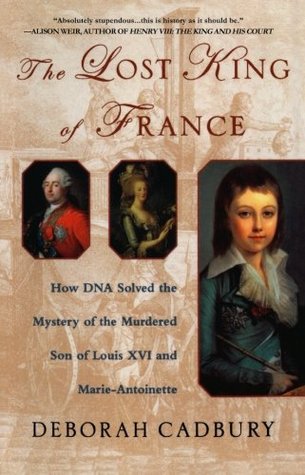
The Blurb (from Goodreads):
In 1793, when Marie-Antoinette was beheaded at the guillotine, she left her adored eight-year-old son imprisoned in the Temple Tower. Far from inheriting the throne, the orphaned boy-king had to endure the hostility and abuse of a nation. Two years later, the revolutionary leaders declared the young Louis XVII dead, prompting rumors of murder. No grave was dug, no monument built to mark his passing. Soon thereafter, the theory circulated that the prince had in fact escaped from prison and was still alive. Others believed that he had been killed, his heart preserved as a relic. The quest for the truth continued into the twenty-first century when, thanks to DNA testing, a stolen heart found within the royal tombs brought an exciting conclusion to the two-hundred-year-old mystery.
A fascinating blend of royalist plots, palace intrigue, and modern science, The Lost King of France is a moving and dramatic tale that interweaves a pivotal moment in France's history with a compelling detective story.
My Thoughts:
I have spent the last two years reading every book I could find on the French Revolution, as that is the setting of my novel-in-progress, The Blue Rose. It is such a fascinating period of history, I’ve really loved being deeply immersed in it.
Most people know the broad outlines of the story: the opulent royal court at Versailles, the uprising of the starving peasants, the storming of the Bastille, and the tragic deaths of King Louis XVI and his flamboyant queen Marie-Antoinette under the merciless blade of the guillotine.
Many people do not know that the royal prince, known as the Dauphin in France, automatically inherited the throne of his father upon his execution. Only eight years old, Louis XVII was kept imprisoned in a dank old medieval prison called the Temple tower. Two years later, he was declared dead. Some believed he had been murdered, others that he had died from abuse and neglect. Still others whispered that he had been rescued, smuggled out from his prison and a dying beggar-boy left in his place.
As time passed, it was these whispers that began to grow. There was no grave, no monument. And when the monarchy was restored in France, several young men stepped forward and claimed to be the true heir. The reigning monarch, Louis XVIII, the brother of the guillotined king, dismissed such claims but pretenders to the throne continued to win supporters. Almost one hundred years after the Dauphin is said to have died, Mark Twain has a con-man in Huckleberry Finn claiming he is the missing ‘dolphin’.
And two hundred years later, scientists have tested an old mummified heart – said to have been cut from the Dauphin’s chest by the doctor conducting the autopsy in the Temple tower – to try and prove, once and for all, if the boy-king died in his filthy prison or escaped, as so many people believed.
It’s an utterly intriguing account of a tempestuous period in human history, and how modern-day science can be used to solve ancient mysteries. I loved it.

